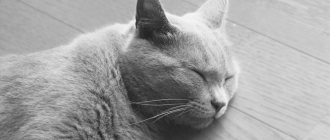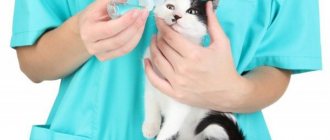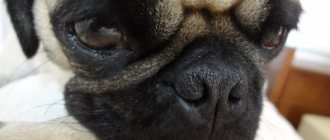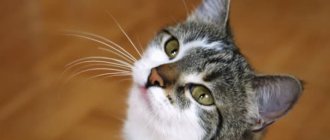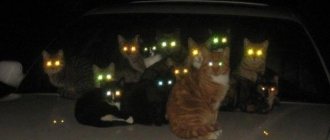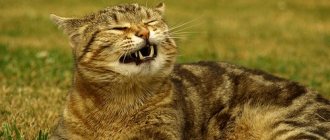9587Administration
All cats sneeze from time to time and, I must admit, it looks pretty funny. However, if a kitten is sneezing and its eyes are watery, this combination of symptoms should cause concern rather than a smile in its owner.
The causes of sneezing in a kitten can be different. The most common are:
- Various infectious diseases;
- Allergic reaction to any irritant;
- Injury or foreign bodies in the nose
It can be extremely difficult to independently determine the exact causes of a pet’s illness and can only be done by a specialist.
© shutterstock
Therefore, if your kitten begins to sneeze very often and his eyes are very watery, it is better to immediately contact a veterinarian.
There are situations in which it is impossible to get immediate qualified help. In this case, you can try to alleviate your pet’s condition by using our advice.
Features of symptoms
Sneezing is not the only symptom indicating that your pet is unwell. Depending on the cause and degree of neglect of the disease, the following clinical manifestations develop:
- eyes are swollen, lacrimation is small, moderate;
- the hair around the eyes falls out, eczema and dermatitis develop;
- the consistency of the discharge changes;
- the animal rubs its head on various objects due to itching;
- dry discharge in the corners of the eyes;
- redness, swelling of the conjunctiva;
- fear of light.
If your pet is constantly sneezing and the tearing does not go away, you need the help of a veterinarian. The doctor will tell you what to do to eliminate the symptoms after an accurate diagnosis is made.
Main problems
There are many conditions characterized by sneezing and watery eyes, but some are diagnosed more often than others. It is worth considering them separately. If other significant symptoms are present, pathology can be identified and treated.
How to tell if your cat has a cold
The cause of the disease is hypothermia of the pet. This is facilitated by a sharp temperature change. To do this, your pet just needs to play actively and then go outside during the cold season.
Swimming in cold water, jumping in the snow, and staying in the rain also contribute to the development of colds.
Characteristic features:
- cough;
- lethargy;
- conjunctivitis;
- temperature increase, but insignificant;
- lack of interest in food;
- snot.
Important! Cold symptoms are in many ways similar to other more serious pathologies, and if in doubt, you should visit a veterinarian and clarify the diagnosis.
To recover, you need to provide your pet with peace, warmth and rest. It is recommended to periodically wash your eyes and nose with a cotton swab dipped in clean water at a comfortable temperature.
If the provoking factor is reduced immunity, then it is recommended to use vitamins and immunomodulators as agreed by the veterinarian. A cold goes away within 5-7 days.
Symptoms of laryngitis
The disease is characterized by inflammation of the mucous membrane of the mouth and larynx.
The cause of development is hypothermia of the throat
The cause of development is hypothermia of the throat as a result of eating cold food from the refrigerator or water, as well as after a long stay outside in winter or exposure to acrid smoke.
Symptoms:
- dry, hysterical cough, gradually turning into a wet one;
- swelling of the oral mucosa;
- foamy discharge from the mouth after a prolonged cough;
- restless sleep;
- wheezing.
To treat laryngitis, various medications are used depending on the cause of development. Only a veterinarian will prescribe an adequate course of therapy.
Attention! Laryngitis can be a sign of deadly viruses such as rabies, so you should see a doctor if these symptoms appear.
Rhinitis in cats
Rhinitis in cats
The pathological process develops against the background of hypothermia, allergies, parasites and various infections. At the same time, the cat has difficulty breathing and constantly opens his mouth.
Additional symptoms:
- inflamed lymph nodes under the jaw;
- sniffling;
- snore;
- dyspnea;
- snort;
- decreased activity;
- lack of appetite.
It is impossible to try to treat rhinitis without knowing the cause of its occurrence. This threatens to significantly complicate the situation and deteriorate the pet’s well-being. To prescribe therapy, consultation with a veterinarian is necessary.
Be sure to read:
Dry nose in a cat: reasons, what should be normal, good or bad, what to do
Sinusitis in cats
Development is caused by a viral or bacterial infection. Sinusitis appears against the background of sinusitis. Mucus accumulates in the maxillary sinuses, and when infection occurs, suppuration occurs.
First signs:
- rubbing the nose with a paw;
- purulent mucus from the nose with an unpleasant odor;
- food preferences change (the cat prefers liquid and warm food);
- mouth breathing;
- the temperature rises by 1-3 degrees.
If sinusitis is suspected, the animal must be taken to a veterinarian and a series of tests must be carried out to confirm the disease.
Treatment is carried out with antibiotics, and in advanced cases, trepanation is used with washing the sinuses with disinfectant solutions.
Allergy
Sneezing and watery eyes may be an allergic reaction . Allergy triggers are often pollen, industrial feed, animal care products, dust, etc.
Sneezing and watery eyes may be an allergic reaction
It is important that the owner can track why the cat developed unpleasant symptoms. This will prevent contact with the allergen.
In the advanced form, additional symptoms appear in the form of:
- vomiting;
- swelling of the mucous membrane;
- skin itching;
- scratching the nose with a paw.
For treatment, antihistamines are used, which are administered orally or intramuscularly.
Polyp formation
Polyps in a cat can be either congenital or acquired due to an untreated allergy or infection. Symptoms may not appear immediately, but as the tumor grows, the pet begins to experience discomfort.
Additional signs:
- snore;
- mouth breathing;
- weight loss;
- head shaking;
- discharge from the ear;
- lack of coordination;
- depressed state.
Polyps are removed surgically. Then a course of antibiotics and corticosteroids is prescribed to prevent the inflammatory process.
Asthma
The suspected cause of asthma is allergies. The disease can be recognized by a paroxysmal dry cough and shortness of breath.
The appearance of unpleasant symptoms can also be caused by other pathologies. But only an experienced specialist can make an accurate diagnosis.
The priority treatment drugs are hormonal agents in the form of tablets, injections, and sprays. Additionally, bronchodilators are prescribed, used during attacks to expand the patency of the bronchi.
Other possible causes of runny nose and sneezing
The appearance of unpleasant symptoms can also be caused by other pathologies. But only an experienced specialist can make an accurate diagnosis.
Other provoking factors:
- foreign object;
- chlamydia;
- viral leukemia;
- immunodeficiency virus
- dental diseases.
Possible reasons
One of the most common reasons for the development of such symptoms is an allergic reaction. Irritants can be:
- household chemicals;
- tobacco smoke;
- fungus on tiles and other surfaces;
- perfume, hairspray, nail polish;
- sprays used in the fight against flies, mosquitoes, and other insects;
- dust;
- cat litter;
- plant pollen.
Tearfulness accompanied by sneezing occurs due to other reasons:
- foreign body in the eye;
- injury;
- failure to comply with pet care rules;
- features of the anatomical structure of the organs of vision;
- various pathologies;
- infections.
Possible diseases
You can tell that a kitten is sick by looking at its condition. The animal's behavior changes dramatically, the pet becomes lethargic and passive.
The reason for this may be:
- colds (runny nose leads to sneezing, watery eyes);
- asthma;
- rhinitis;
- conjunctivitis;
- helminthic infestation;
- neoplasms, polyps;
- pathology of teeth, gums;
- immunodeficiency;
- rhinotracheitis;
- malignant processes.
Infectious causes
The cause of the deterioration of the cat’s condition may be an infectious disease that must be identified promptly, because a sick animal can infect other pets.
Pathologies that cause sneezing and tearing:
- Herpesvirus (infectious rhinotracheitis). Against the background of the disease, there is a risk of developing ophthalmological problems. The pet's condition can rapidly deteriorate.
- Mycoplasmosis, chlamydia. Treatment of these diseases begins immediately after diagnosis.
Causes of sneezing and tearing in one eye
Among the reasons why a cat sneezes, but only one eye is watering, are the following:
- eye injuries;
- ingress of smoke, chemicals, caustic vapors;
- narrowing of the tear duct;
- entropion of the eyelid;
- helminthic infestation;
- congenital ocular abnormalities;
- conjunctivitis.
Causes of nasal congestion in cats
Nasal congestion in cats is not an independent disease, but rather refers to signs of both mild ailments and serious and dangerous pathologies. The sense of smell is the most important sense for these animals, so if the first symptoms of a runny nose, difficulty breathing or excessive nasal discharge appear, you should consult a veterinarian. There can be many causes of the disease, but the most common are the following.
Cold
The most obvious cause of nasal congestion is, of course, a cold. A cat can catch a cold as a result of prolonged exposure to a draft or due to simple hypothermia. As a rule, in these cases symptoms such as general lethargy, weakness and tearfulness also appear. Sometimes the animal's eyes can even fester.
Viral or bacterial disease
Small kittens that have not yet developed a strong immune system are most susceptible to viral and bacterial diseases. At the same time, adults are also not immune from them. A cat can pick up the virus both during communication with unhealthy relatives and as a result of contact with contaminated objects: after sniffing outdoor shoes or rubbing parts of the body against them.
Only a doctor can identify a viral or bacterial disease
Viral infectious diseases found in cats:
- flu (cat);
- infectious rhinitis (the causative agent is most often the herpes virus).
Bacterial infectious diseases include:
- mycoplasmosis;
- pasteurellosis;
- chlamydia.
Only a correct examination will allow us to establish the cause of the disease and prescribe treatment, so the primary task is to diagnose the disease.
Allergy
Sometimes nasal congestion can be caused by an allergic reaction. Pedigree animals are more susceptible to various types of allergies. Most often, pets begin to snort and sneeze when in contact with:
- plant pollen;
- dust;
- hot steam;
- food;
- particles of household chemicals;
- flavorings.
If the consistency of the animal's nasal discharge is liquid and transparent, then most likely the cause of nasal congestion is an allergic reaction. A side symptom of the disease is watery eyes. In this case, it is necessary to identify the allergen and remove it from the living space. If you manage to guess and neutralize the provoking factor, then in the near future the cat will be able to feel significant relief. In addition, antihistamines can be used as an auxiliary measure for a speedy recovery of the animal (allowed to be used only after being prescribed by a specialist).
Parasite infestation
Nasal congestion and difficulty passing air through the respiratory system in cats can also occur as a result of infection with helminths - parasites whose habitats include the lungs of the animal. They can provoke diseases such as pneumonia and rhinitis.
Decreased immunity
With a weakened immune system, the animal is at greater risk of nasal congestion and runny nose. In this case, the cat will have a light-colored mucus discharge on his nose, and his body temperature will also increase. The pet will become lethargic, curl up in a ball and lie down, not even reacting to food.
Decreased immunity causes general lethargy
Associated symptoms
Deterioration of the condition is accompanied by the following symptoms:
- hot nose;
- temperature increase;
- apathy;
- weakness;
- loss of appetite;
- sometimes blood comes from the nose;
- a sharp decrease in body weight;
- ulcerations, skin rash;
- purulent discharge from the eyes, nasal passages;
- breathing is accompanied by whistling, wheezing;
- cough;
- gagging;
- diarrhea.
These signs indicate the development of a serious illness. Immediate veterinary assistance is needed.
Infectious diseases of Maine Coons
Cats of this breed are susceptible to several serious viral diseases that can greatly compromise their health. Therefore, it is very important to detect the disease in time and begin its treatment.
- Calicivirus is a respiratory infection that affects the respiratory system and watery eyes. The animal often sneezes, ulcers appear on its tongue and palate, its eyes water, and snot appears. In advanced cases, the pet may develop bronchitis, pneumonia and catarrhal tracheitis.
Treatment of kilicyvirus infection involves taking antibiotics and desensitizing therapy. The animal's mouth is irrigated with antiseptics. If necessary, your veterinarian may prescribe eye drops. A sick Maine Coon needs to be provided with comfortable living conditions, a complete diet of soft foods and vitamins.
- Herpesvirus is a disease similar in nature to calicivirus, but accompanied by much more severe symptoms. With herpes virus and Maine Coon, the respiratory system is also affected, the eyes are affected and profuse serous-mucous discharge from the nose appears.
In severe cases, the development of the disease can cause damage to the cat's digestive tract, which may result in loose stools and vomiting. Premature births often occur in pregnant individuals.
Treatment of herpesvirus is based on the use of immunomodulators and antibiotics. Also, the sick animal is given vitamins and medications are instilled into the eyes and nose.
Diagnostic methods
At home, it is difficult to determine the exact cause of the cat’s deterioration. You need to seek help from a veterinarian . During the diagnosis, the animal is examined, body temperature is measured, and an anamnesis is collected by interviewing the cat's owner.
The following studies are prescribed:
- general and biochemical blood test;
- Analysis of urine;
- taking swabs from the nasal cavity and throat;
- nasal endoscopy;
- X-ray of the head.
How to help a sick animal at home
It is impossible to treat a cat without knowing the cause of the pathology. Need specialist advice.
Conditions favorable for the sick animal are created at home:
- contact with potential allergens is excluded;
- drafts and other negative factors are eliminated;
- Wet cleaning is carried out in the room;
- pet care rules are followed.
The best solution is to immediately consult a doctor. But there are situations when there is no veterinarian nearby.
Remedies that can help in this case:
- Furacilin (used for washing the organs of vision for conjunctivitis);
- an aqueous solution of Levomycetin (helps eliminate bacterial conjunctivitis, the product is instilled into both eyes);
- antibiotic-based ointments;
- solution of Novocaine, Hydrocortisone (eliminates pain, used as injections);
- Hormonal drugs are indicated in case of the development of a severe allergic reaction.
Drug therapy
Therapy is aimed at eliminating the causes of the painful condition. The following groups of drugs are prescribed:
- antibiotics;
- antiallergic drugs;
- antiviral drugs.
Measures are being taken to strengthen the immune system.
The following drugs are prescribed:
- Anandin . It has a wound-healing, antiphlogistic effect, relieving inflammation.
- Maxidin . Characterized by an immunostimulating effect. Helps activate the body's protective functions.
- Thymogen . It has an immunomodulatory effect similar to Maxidin.
If these drugs are ineffective, then resort to the use of strong drugs, including:
- Naphthyzin. Has an anti-inflammatory, vasoconstrictor effect.
- Dioxidine. The drug has an antiseptic effect and is used for the development of purulent rhinitis.
- Derinat. Immunomodulatory agent that activates defenses. Helps cope with conjunctivitis and rhinitis.
- Nazivin. Has a vasoconstrictor effect. It is used to identify inflammatory processes in the respiratory and vision organs.
- Galazolin. Used to treat otitis and rhinitis.
Severe forms of pathologies are treated with the following medications:
- Diamond eyes;
- Furacilin;
- Iris;
- Tsiprovet;
- preparations based on Levomycetin.
Application of traditional medicine methods
Folk remedies are not used as the main treatment. Decoctions and infusions are used in combination with drug treatment.
The following will help relieve symptoms:
- Chamomile decoction. This is a universal remedy used for washing the organs of vision. The procedure is performed up to 3 times a day.
- Potassium permanganate solution (potassium permanganate). Used to wash eyes. It is necessary to ensure that the crystals are completely dissolved in water, otherwise the animal will receive a burn to the mucous membrane. The solution should be of low concentration and have a pale pink tint.
- Decoctions of sage, St. John's wort, calendula. Used at the beginning of the purulent process.
- Black tea without additives. They are used to wash the eyes during inflammation.
What to do if your cat sneezes and his eyes water?
Fellinologists often complain about their pets being tearful. Some turn to a veterinarian, others try to cope on their own, by washing the eyes with herbal decoctions, water, weak tea, while others leave everything as is, hoping that it will go away on its own.
Sometimes cat owners notice that their pet is sneezing. If dust gets into your nose, then there is no reason to worry. But when a runny nose becomes permanent, it is necessary to establish the cause and take measures to eliminate it.
The reason for immediately seeking veterinary help is the simultaneous presence of symptoms of a runny nose and lacrimation. If there are no other clinical signs, then an allergy or an early stage of an infectious disease is suspected.
